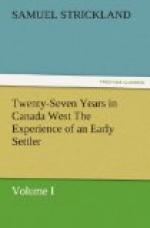If I could have purchased land on the lakeshore, I should have liked to settle in Darlington; but I found the farms I fancied much too high-priced for my pocket. So at last I made up my mind to go back to the new settlement of Peterborough, and see what sort of a place it was, and what it was likely to become.
Accordingly, I started on my journey, and travelled east, along the Kingston road, parallel with the shore of lake Ontario for about twenty-four or five miles to the boundary line, between the townships of Hope and Hamilton. After this I walked for twenty-seven miles through Cavan and Monaghan, to the town of Peterborough, which, at that time contained one log-house and a very poor saw-mill, erected some five or six years before by one Adam Scott to supply the new settlement of Smith with lumber.
I found several hundreds of Mr. Robinson’s Irish emigrants camped on the plains. Many had built themselves huts of pine and spruce boughs; some with slabs and others with logs of trees. Three or four Government store-houses and a house for the Superintendent, the Hon. Peter Robinson, were in course of erection. I had letters of introduction to that gentleman, and also to the Hon. T. A. Stewart, and Robert Reid, Esq. The two latter gentlemen resided in the township of Douro, and were at that time the only settlers in that part of Canada.
As I did not much like the appearance of the lodgings I was likely to obtain in the new town, I went on to Mr. Stewart’s house, and presented my credentials. Nothing could have been more cordial than the welcome I received from him. This gentleman and his brother-in-law, Robert Reid, Esq., obtained a grant of land from the Colonial Government, on condition that they would become actual settlers on the land, and perform certain settlement duties, which consisted in chopping out and clearing the concession lines.* Before the Crown patent could issue, the party contracting to perform the settlement duties was obliged to appear before a magistrate, and make an affidavit that he or they had chopped and cleared certain concession lines opposite the lots of land mentioned in the certificate.
[* Every township is laid out by the surveyor in parallel lines, sixty-six chains apart. These lines are sixty-six feet in width, and are given by government as road allowances, for the use of the public, and are called concession lines. Cross lines run at right angles with the former every thirty chains, and are called lot-lines: they subdivide the township into two hundred acre lots: every fifth cross line is a road allowance.]
This was a bad law, because many of these lines crossing high hills, swamps or lakes, were impracticable for road-purposes: many thousand pounds consequently were entirely and uselessly thrown away: besides, it opened a door for perjury.




